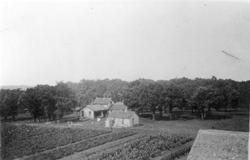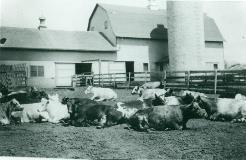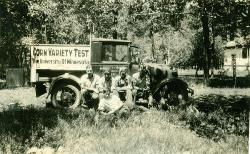Reprinted, in part, from Minnesota Science and Waseca County News 75th Anniversary Issue – June 1988
In 1910, Minnesota farms produced food for their families with the hope that enough surplus food could be sold to exchange for salt, sugar, clothing, and hardware. By then, horses had replaced oxen as farm power units. But anything a horse’s pull could not accomplish required hard work. Markets were uncertain, roads muddy, farm families isolated, and agricultural information limited.
But changes came fast. Self-tying binders allowed farmers to expand their grain fields. Horse-drawn mowing machines replaced the scythe. Mowers, rakes and tedders cut and windrowed the hay. Machines pulled by horses made corn planting faster and easier than before, marking and checking in one operation. A team of horses could pull a single row cultivator. Some “corn plows” even had a seat for the operator. But the size of the cornfield was limited to what could be husked by hand. Threshing machines with chugging steam engines replaced horse-drawn threshers.
Even livestock changed. A distinction was made between milk cows and beef cattle. Almost every farm kept some cows, two or three for the children, at least. Farm women made butter and cottage cheese. Some butter they traded at the store for cooking and eating utensils and other supplies. Steer calves provided meat. Hogs got meatier, with more ham and loin, and less bone snout. Scattered chickens picked at barnyard manure during the day and roosted in trees by dusk. When the kids could find the nests the family had eggs for eating or trading.
Tired farmers wondered, “Was there a better way?” Could losses from insects and disease be reduced? Could markets be improved? Was there better seed?
At the University of Minnesota Agricultural Experiment Station. Andrew Boss started a study of farm operations. He persuaded groups of farmers to give the UM station fairly detailed records of their operations. (These routine studies of farm expense and income were continued and used as a pattern for similar studies in other states.)
Boss felt that a practical farm, using the best-known procedures, could make a profit. If so, this would do more than anything else to gain farmer acceptance of the new discoveries made at the experiment stations.
The Legislature of 1911 made provision for the establishment of two Demonstration Farms where local problems such as cutover land in the north and drainage in the south could be explored by Department of Agriculture personnel. In August 1912, The UM Board of Regents purchased 246 acres of land lying half a mile southwest of Waseca and bordering on the city limits. Possession of the farm was taken April 1, 1913. Albert Hoversten, a UM graduate, was employed as farmer. Since the legislative enactment called for a demonstration farm and experiment station, the land purchased was organized into two definite units: 1) the demonstration farm, and 2) the experimental unit. The demonstration farm was organized with a view to demonstrating the correct principles of crop rotation, good livestock management, and desirable farm equipment.
“When the land for this station was purchased, it was so cut up by ponds, sloughs, and mud holes that only the irregular patches of higher ground could be farmed,” said Boss in 1935. “The intention was to make this a drainage and farm management demonstration Some tiling was done and combined with dry weather and the general lowering of ground water levels, this has made it possible to cultivate almost every foot of land except in very wet seasons.” Some researchers called the Southern Experimental Station a “mud hole” or, when it rained a lot, a “sea of mud”. But that was as planned because the UM researchers intended to reclaim the land through drainage. They tapped ponds with tile lines, cut through high ground to the south and eventually had the site thoroughly tiled.
Cows were purchased in 1915. Additional purchases were made until, in 1918, the herd consisted of 20 cows and 28 head of young stock. From 1917 to 1948, a cattle project was designed to test the possibilities for milk and meat production from grade cows of milking shorthorn breeding. Disease upset the production.
In 1918, the first tractor was purchased by the Southern Experimental Station to furnish belt power for the silo filler and threshing machine. It was a Case 3-wheeler with an impulse starter.
In 1919, Robert E. Hodgson took over the local direction of the work under Boss’s direction and gradually the experimental projects increased.
The original flock of sheep at Waseca consisted of about 20 ewes. Hodgson reported, “The small flock of Shropshire sheep maintained at the experiment station has returned the largest percentage of profit of any class of livestock. They have been handled strictly as a market proposition although they are all registered. Throughout the spring and summer they trim the lawn at the experiment station which would otherwise require the work of several men. They glean in the field after the crops are cut and in the winter are fed corn silage and soybean straw. As management improved, the flock became more prolific and by 1926, the station flock of about 40 registered Shropshire ewes attracted buyers for all the surplus animals.
In 1919, William Watts, Sr. was caretaker of the dairy herd. He had grown up in England and had learned to shear sheep, so he undertook to remove the wool from a yearling ewe in three minutes flat.
From 1913 to 1923, horses furnished practically all of the power used on the farm. Boss selected the original teams, and colts were raised for replacements. In 1920, a purebred mare Percheron, a French breed of horse, was purchased, and her descendants eventually provided some fine work stock.
The threshing machine on the farm in 1919 required that bundles be cut and fed into the cylinder by hand. Straw was delivered by a windlass conveyor and required two to three men to carry it away and stack it. Grain was delivered into half-bushel measure on the ground and dumped into sacks, which were lifted into a wagon at the granary, it was the general practice to shoulder the sacks, climb the stairs, and dump the grain into the bin. It was essentially the old horsepower thresher operated by belt instead of tumbling rod.
Grain binders were one of the machines usually pulled by four horses. Horses should have been thankful when light, rubber-tired tractors took over this hot job, but it required two men for the operation, and the bundles still had to be shocked and picked up by hand. Small combines soon eliminated binders, threshing machines, bundle racks, pitchforks, and grain wagons. Power-operated elevators and conveyors replaced scoop shovels and muscle.
A swine breeding project was started in 1924 by purchasing six registered bred gilts. In 1928, UM animal geneticist L. M. Winters became interested in the swine breeding problem. Several pigs were taken to St. Paul campus, and Winters experimented with artificial insemination of sows. At the Waseca Station, attempts at experimental inbreeding became desperate. Researchers there even tried dousing a sow with cheap perfume to make her more attractive to a boar.
One line of pigs was instinctively “wild” according to Hodgson. “This wild instinct seemed inherent in all of the N line. There was a standing offer of $5 to anyone who could separate an N female of any age from the group and drive her alone through a 16-foot gate. The reward was never collected.”
The work with Minnesota No. 1, 2, and 3 hogs, using crossbred foundation for selected progenies designed to cross well for commercial use, seemed to be more productive than selection within a breed. This led to the development of a similar plan with sheep, and each station was assigned a specific part of the project. “Winters designed this experiment,” according to Hodgson, “with the hearty approval of all animal husbandry departments, another example of his ability to promote cooperative action on a problem too large for any one unit”.
The part assigned to the Waseca Station was to develop a large sheep, designed particularly for fast-growing, early-maturing lambs of superior market quality. Wool was of secondary importance, but a heavy fleece, with as much quality as possible, was desired. The proposed line was called Minnesota No. 102.
Back when the Southern Experiment Station began operations, all of the corn grown in Minnesota was open-pollinated. White varieties were almost exclusively used in the Waseca area because experience had demonstrated that they were better adapted to low, wet ground and short seasons. Lodging was expected, and picking half the ears from ground level was normal. Fifty bushels was a good average crop. Wheat had been the major crop, but this was being pushed northward as the corn acreage increased.
In 1925, the Corn Belt experiment stations and the USDA arranged a cooperative project on corn improvement. From then on, there was free exchange of information and promising material. Inbred lines from Illinois, Ohio, and other states were grown in the Waseca plots. By 1930, Dr. H. K. Hayes had some promising inbreeds of Minnesota 13, Rustler White, and Northwestern Dent.
Experimentation continued and their first Minhybrid, numbered 301, was promoted and distributed from the Waseca Station The increased yields of corn made possible by hybrid seed and disease control has been one of the most productive accomplishments of the UM Agricultural Experiment Station. Better seed more than doubled productive ability, and improved cultural methods helped to make corn a main crop. “This spectacular addition to Minnesota farm wealth by corn improvement,” said Hodgson, “has been made possible by the ability and dedication of many skilled and well-trained research men. Without doubt, Dr. H. K. Hayes leads the list”.
“The Waseca Station has been most fortunate to have had an active part in this revolution of ideas,” said Hodgson in 1963. “Its location in the southern part of the state and the availability of good corn soil were important factors, but the ability and skill of the men who worked on the corn project were also of first importance. Even the boys in the ‘chain gang’ who hoed the weeds from 40 acres of corn plots, made some 20,000 hand pollinations, and helped to harvest the plots were important. Great effort went into the corn project, but nothing could have been more rewarding. It’s hard to believe that only a few years ago, hybrid seed corn was a suspected stranger in Minnesota.” Boss lived to see his mud farm raise 125 bushels of corn per acre. Such yields were not even pipe dreams in 1913.
In the spring of 1919, a few bushels of seed labeled, “Habaro Soybeans” were found in the St. Paul UM granary. This was a new crop so far as Minnesota was concerned. It was hardly mentioned in agronomy courses. Albert C. Arny had planted a few variety tests at the central experiment station in St. Paul, but most Minnesota farmers had never heard of them. Early varieties would also grow in the southern part of the state, of course, but what use could be made of them? The soybean variety, Hodgson, developed by Dr. Jean Lambert had a part of its history at the Waseca station and was named in honor of the former superintendent.
Very significant changes have occurred in the research program at the Southern Experiment Station. The goals of research have also changed a great deal. It is easy to see in earlier accounts that increased production was of paramount importance. Today’s research programs have a different agenda. Increased production is a legitimate goal only if it results in greater profitability. In many cases, the purpose of research is to determine if limited input costs might show greater profitability at lower than maximum production levels. While efficient production practices are still the goal of Southern Experiment Station researchers, they must, at the same time, work towards the development of technologies that will have a positive impact on the environment, soil conservation, energy conservation, water quality and the entire spectrum of factors that will contribute to the sustainability of agriculture.



